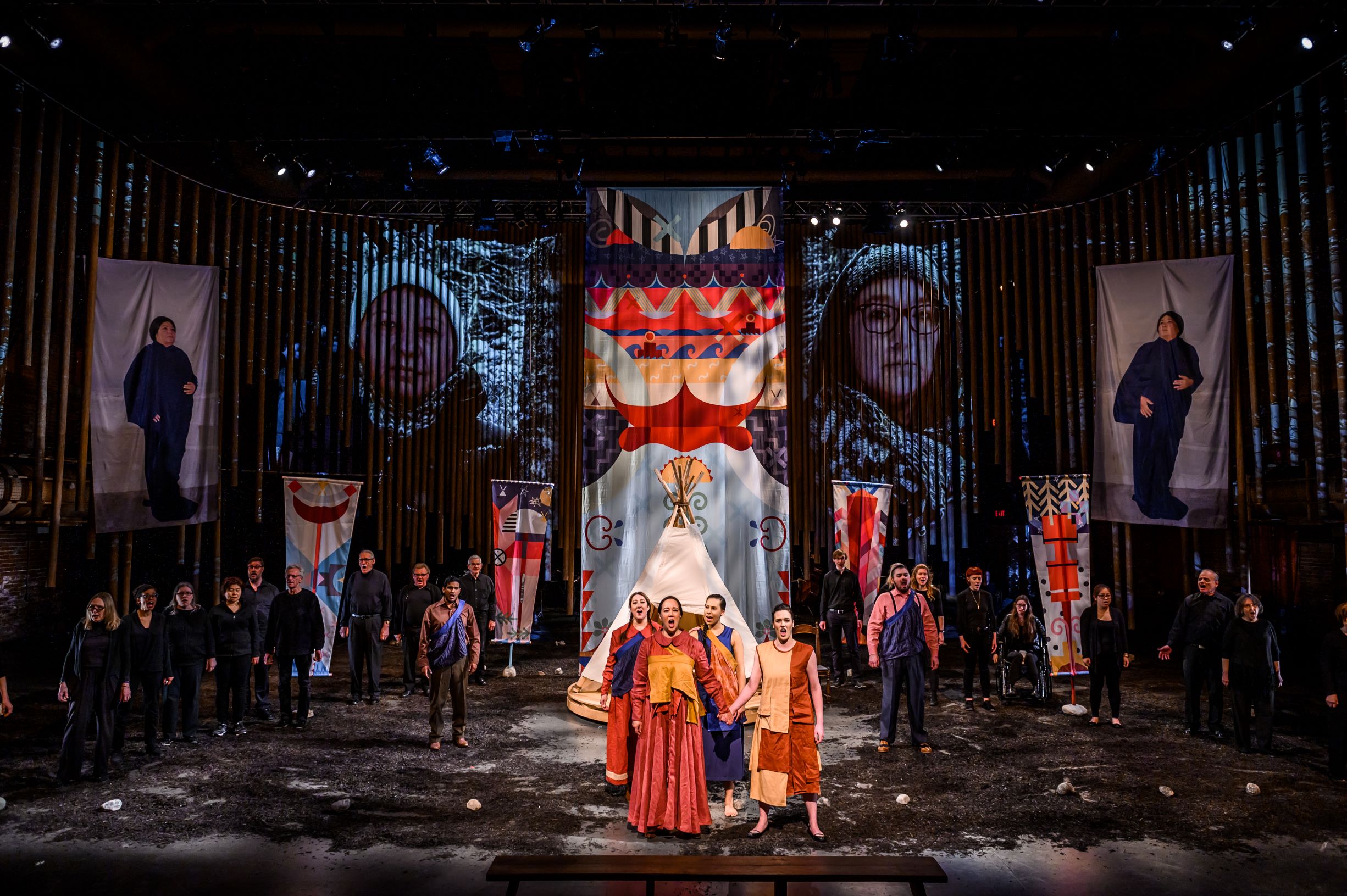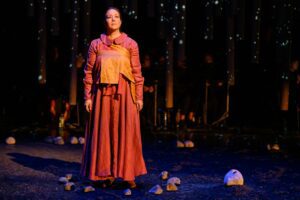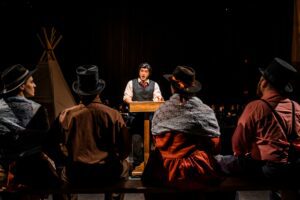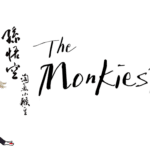Shanawdithit, with music by Dean Burry and libretto by Yvette Nolan is the story of Shanawdithit, last surviving member of the Beothuk people of Newfoundland who died before turning thirty, in 1829. The opera goes beyond simply narrating the last year of Shanawdithit’s life in William Cormack’s home in St. John’s, and her recollections of life with her family. It is also about how we remember and tell stories. The ‘official’ story of the Beothuk, as told in Canadian school books, is based on Western archaeology and anthropology. It is a story from the perspective of the people responsible for the genocide of the Beothuk.
Shanawdithit sets out to recover the story from an Indigenous perspective. The creative team worked with a number of advisors from the Mi’kmaq—the people with the richest memory of the Beothuk in their oral tradition. Additionally, the cast includes people from First Nations, Métis and Inuit ancestry. Nolan herself is Algonquin while Burry is a Newfoundlander who has lived with the settler version of the story for decades.
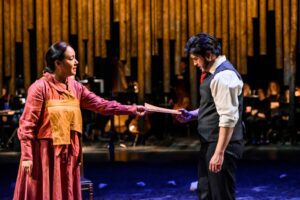
Marion Newman (Shanawdithit) and Clarence Frazer (Cormack) in Tapestry Opera’s Shanawdithit. Photo: Dahlia Katz
As the opera opens we see Shanawdithit as a maid in the house of John Peyton, where she is known as ‘Nancy April’. She is transferred to live with Cormack, a Newfoundlander with a fascination and respect for the native people of the island. She regains her identity as Shanawdithit and begins to open up to Cormack. We see the sketches she produces for him (still extant) and their discussions about Beothuk language and life. There is a tension here.
From her perspective, why does Cormack care? It’s plain that his neighbours have no regard for the people that they view as ‘savages’. Who is she telling her story to and why? In the opera’s pivotal aria she sings, in broken phrases, “How can I sing to descendants I will never have?” There are no good answers of course, but the opera ends optimistically. Shanawdithit knows her time on earth is coming to an end and, approaching death, her people in the Spirit World assure her that her story will be told.
So how does this all work as opera? First there’s a very tight, and very singable, libretto. The words matter and, even in the cavernous acoustic of the Imperial Oil Theatre, the principals are all audible, though the chorus sometimes seems to disappear into the roof space. Narrative and the broader questions posed by the piece are well integrated. The music is intriguing and supports the libretto well. Burry utilizes the natural sound world of Newfoundland and the North Atlantic. In addition to an eleven-piece chamber ensemble led by Music Director Rosemary Thomson, there’s use of natural elements like rocks and gravel shakers by the chorus.
But that’s just the starting point for a piece that sounds like it’s using a much bigger orchestra than is actually the case. There’s an ebb and flow to the music. Burry doesn’t try to hurry things along. There’s room for numbers, like the Shanawdithit aria mentioned above, where incomplete phrases–verbal and musical–resolve into the final question. There’s a scene near the end where Simms offers to care for Shanawdithit after Cormack has gone broke and must leave St. John’s. Here, the music briefly quotes the hymn tune ”The Day of Resurrection” in a broken orchestration to disturbing effect. It’s all quite accomplished and, while there are no vocal pyrotechnics, it serves the story and offers the singers real opportunities for expressive singing.
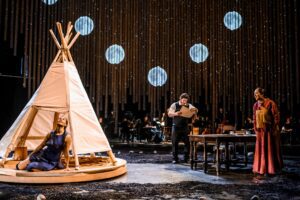
(l-r) Aria Evans (dancer), Clarence Frazer (Cormack), and Marion Newman (Shanawdithit) in Tapestry Opera’s Shanawdithit. Photo: Dahlia Katz
The visual elements of the production are important, too. Five Indigenous artists, inspired by Shanawdithit’s sketches, created artworks in various media that are incorporated into the set. Projections by Cam Davis decorate the high walls of the theatre showing giant figures in a Newfoundland winter, elements of Shanawdithit’s sketches, and a brilliant invocation of the night sky. Dance, choreographed by Michelle Olsen and performed by Aria Evans, is integrated throughout the piece in an organic way. Co-directors Nolan and Michael Mori effectively weave the various elements into a coherent whole.
Two singers and the relationship between them are central: Marion Newman in the title role and Clarence Frazer as Cormack. Both are first class. Newman uses her rich mezzo to convey Shanawdithit’s confusion and vulnerability while making every word clear. Frazer is equally articulate in conveying the feelings of a man trapped between two worlds. Ultimately, he is irrevocably rooted in the settler world. He has a beautiful voice that overcame the acoustic challenges of the space.
The Spirit Chorus of Rebecca Cuddy, Asitha Tennekoon, Evan Korbut and Deantha Edmunds also took on a variety of supporting roles. Tennekoon, playing the racist Peyton, was particularly impressive while Cuddy was moving in the final scene. The chorus, from Toronto City Opera, was positioned towards the back of the stage area and sounded atmospheric but words were mostly lost. While the principals could be mostly understood without surtitles, their inclusion might have been a good idea anyway.
Shanawdithit is an effective and accomplished piece of music theatre that deals with an important story and raises questions about how we perceive and transmit our stories. It is being presented by Tapestry Opera at Toronto’s Imperial Oil Theatre until May 25th. Then, on June 21st it moves to St. John’s under the auspices of Newfoundland and Labrador’s Opera on the Avalon, the piece’s co-commissioning company.

